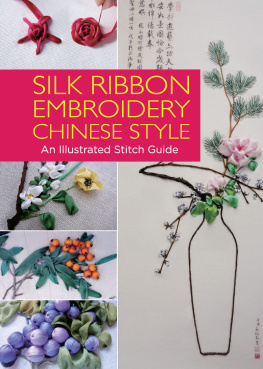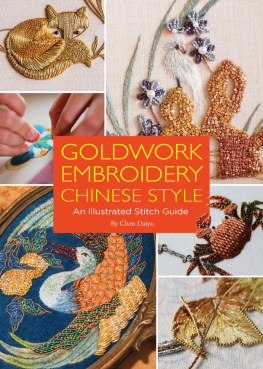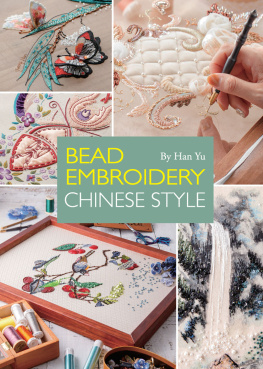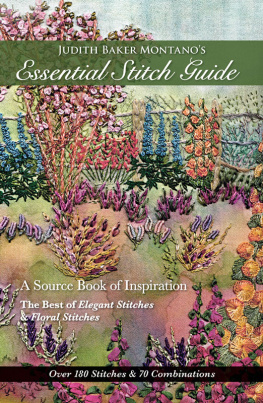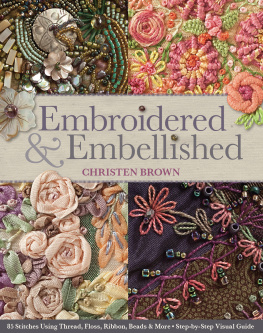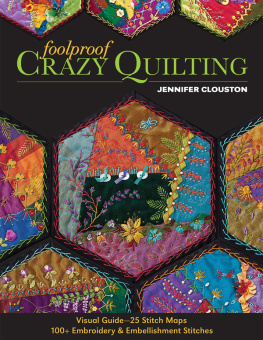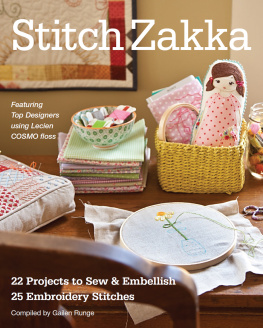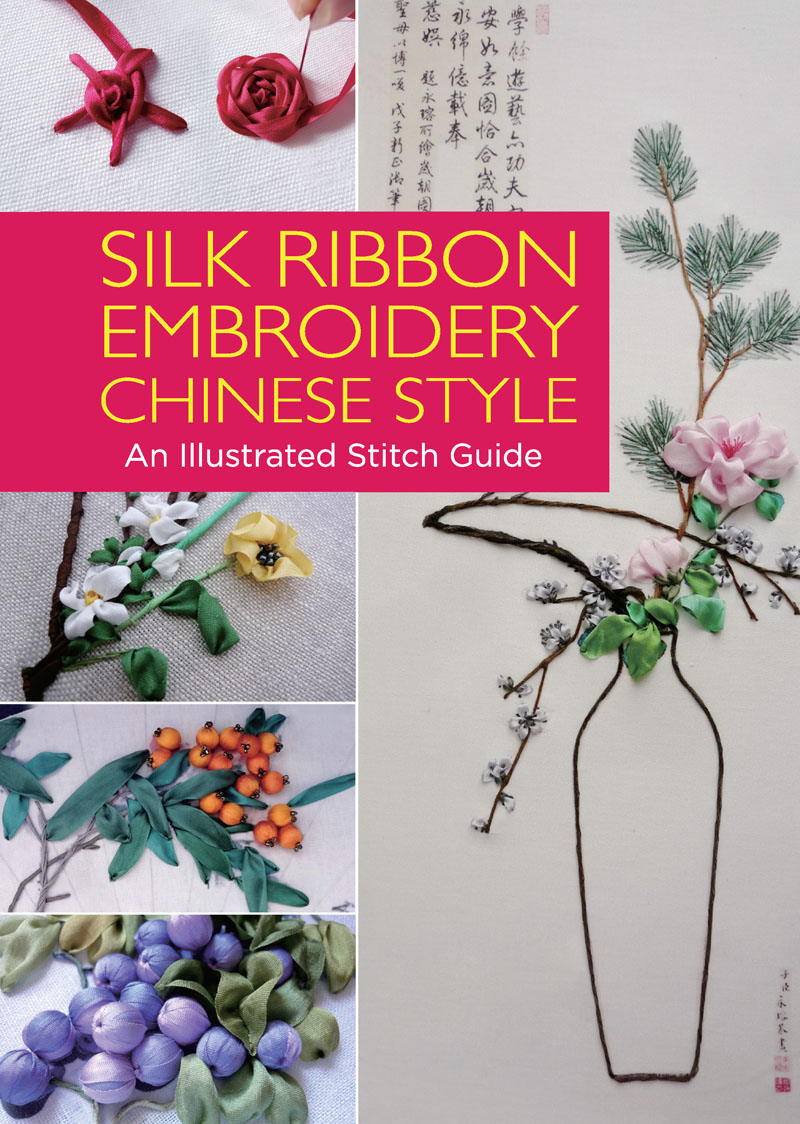

Editors Note
The lessons in this book are composed of a great number of color ribbons. Some colors in the same scheme look very similar and yet different. Therefore, we list the colors and color numbers of the selected ribbons for each project to help you identify the various ribbons more easily. They are only for your reference. You can simply buy ribbons with similar colors. Of course, you can also adjust the colors according to your design to create a personalized art.
On
Fig. 1 Summer Lotus Pond
The soft and smooth qualities of the green silk ribbon are fully reflected in this embroidery. Curling it inwards truly portrays the natural form of lotus. The verdant leaves seem like swaying in the breeze while the cute little pink dragonfly dancing above them, flapping its beautifully translucent wings. This embroidery is in a simple and harmonized composition, displaying the beauty and peacefulness of the summer lotus pond.
On
Fig. 2 The Lady of Peach Blossoms (section)
These pink peach blossoms are plump and warm. The petals are falling from the swaying branches like a spinning dress of a dancer. The colorful butterfly approaches them and is captivated by the fragrance. See for the instructions.
Copyright 2017 Shanghai Press and Publishing Development Co., Ltd.
All rights reserved. Unauthorized reproduction, in any manner, is prohibited.
This book is edited and designed by the Editorial Committee of Cultural China series
Text and Photographs: Yuan Weilin
Translation: Kitty Lau
Cover Design: Wang Wei
Interior Design: Li Jing, Hu Bin (Yuan Yinchang Design Studio)
Editors: Wu Yuezhou, Cao Yue
Editorial Director: Zhang Yicong
Senior Consultants: Sun Yong, Wu Ying, Yang Xinci
Managing Director and Publisher: Wang Youbu
ISBN: 978-1-60220-027-2
Address any comments about Silk Ribbon Embroidery: Chinese Style to:
Better Link Press
99 Park Ave
New York, NY 10016
USA
or
Shanghai Press and Publishing Development Co., Ltd.
F 7 Donghu Road, Shanghai, China (200031)
Email:
Printed in China by Shenzhen Donnelley Printing Co., Ltd.
3 5 7 9 10 8 6 4 2
CONTENTS

Fig. 3 The Spring Equinox
The Spring Equinox (Chunfen) is one of the 24 Chinese solar terms. This is the booming time in spring when the Mother Nature displays the picture of warmness and vitality. This embroidery uses a few basic techniques and various shades of green ribbons to demonstrate the plump buds among the branches, creating a scene of life and energy.
Preface

Fig. 4 Peace and Blessings (section)
The most eye-catching component of this embroidery is the pink rose in full bloom. But if you savor the picture for a while, you will find that the supporting plum blossoms and pine needles are also embraced with graceful and lofty spirits. The overall composition is colorful and yet not disordered. See for instructions.
I have been in love with handicraft since I was little. As a crazy handicraft lover, I have tried different types of arts and crafts such as paper art, fabric art, leather craft, flower arrangement, weaving, embroidery and more.
I was deeply attracted to silk ribbon embroidery when first seeing it on a foreign website back in 2002. This art was not very popular in China at that time and very little resources and materials could be found. As a result, I did self-learning via various channels from the internet. After ten years of constant exploring and researching, I have created my unique style of art, fusing the western silk ribbon embroidery with Chinese ink-wash painting.
Silk ribbon embroidery is known to be three dimensional, life-like, and diversified, but it mostly takes flowers and plants as its theme. After a long period of time, it becomes tedious. During the process of continuous exploring, I have challenged myself with different elements of other areas, for example, animals, architecture, and Chinese motifs. In this book, you will find a lot of silk ribbon embroidery crafts that are infused with Chinese elements such as Ink-Wash Shrimps, Huizhou Architecture, and Cloud Pattern Key Holder. They have gone through a long exercise of concept design and various stitching trials to be completed. The process is very complicated and yet produces an exclusive result.
In 2008, I left my full-time job to join the silk ribbon embroidery profession. To submerge myself in a favorite handicraft and develop it to a career, I experienced a difficult beginning. The enthusiasm that accompanying me all these years has helped me break through all the obstacles and form my unique style, which was recognized by my friends in the arts and crafts field.
I have collected my works from all these years, incorporating comprehensive instructions and illustrations, so that you can follow the steps to produce the embroidery art. You can also draw inspiration from them, along with the fundamental techniques, to create works of your own style.
CHAPTER ONE
Characteristics of Chinese Style Silk Ribbon Embroidery

Fig. 5 A Few Peach Blossoms (section) , see .

Fig. 6 Bistorts
Above the river of autumn the bistorts are swaying,
On the shore of weeds the sun is setting.
A famous Chinese poet Bai Juyi (772846) composed the poem to fully illustrate the beautiful scene of bistorts on the autumn river. The little pink and rose red flowers are clustered and intertwined, bending their branches, and hiding behind the green leaves, like a group of charming shy girls.

Fig. 7 The Red Cherries and Green Plantain Leaves
This embroidery is inspired by a poem of Jiang Jie (12451305), a famous Chinese poet of the Song Dynasty. The bright and joyful spring scenery is in stark contrast to the gloomy mood caused by homesickness of Jiang. The red cherries bloom in the late spring and the green plantain leaves represent summer, connoting the quick passage of time. The pleated gradient green ribbon tactfully presents the organic form of the plantain leaf. The plump red cherries are waiting to be picked and tasted. Meanwhile, the cricket under the leaves breaks the static picture, adding more vitality to the scene.
S ilk ribbon embroidery is an antique embroidery and still very popular nowadays. It is believed that it made its first appearance in the 18th century in France. At that time, it was mainly used for decorating the royal and court dress. The floral designs on the fabrics were extremely beautiful and luxurious. Within a short period of time, silk ribbon embroidery was like a gust of wind blowing from the French palace to other countries. Today, it can be found everywhere such as on purses, pincushions, pillows, blankets, hats, fashions, and home decorations.
Next page
